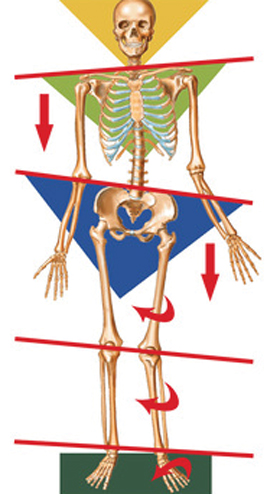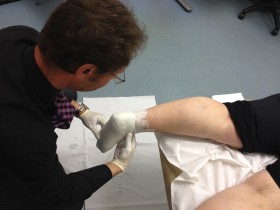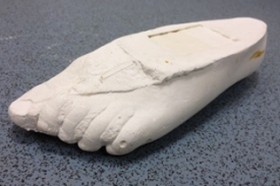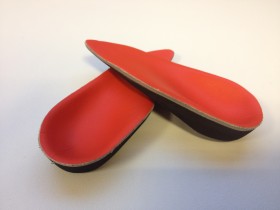A Musculoskeletal examination involving the application of Podiatric Biomechanics to evaluate the primary underlying structural causes of your presenting symptoms, be they at foot/ankle, leg, knee, pelvis, low back or spinal levels and the postural inter-relationship between these anatomical areas.
It is very important to understand that patients need to be examined as a whole as many conditions are commonly interlinked and form a “chain reaction” of structural events that will affect all major joints and muscle groups.
What happens during a biomechanical assessment ?
After taking a detailed medical history, examination of both the upper and lower limbs is undertaken to both visually observe and measure the mechanics of both your walking and running patterns and to study the inter-relationship between major joints, muscles and nerves that support your skeleton so that we can assess the mechanisms that have contributed to your presenting complaint, be that any combination of muscle weakness, reduced nerve sensation and poor skeletal alignment.
In some circumstances it maybe necessary to combine this examination with video-gait analysis, where footage and stills can be analysed in slow motion.This is often used when assessing patients with complicated gait patterns e.g Cerebral Palsy, Polio, Stroke.
Video-gait analysis also provides a record to reassess improvement over time.
Postural analysis forms a large part of this examination and the effects that posture has upon gait patterns and the weightbearing examination.
It is vitally important to consider some of the following:
- Head tilt and Jaw position
- Neck position and Shoulder tilt/rotation
- Arm length and Low back position
- Pelvic tilt/rotation and Leg length
- Knee position
- Ankle and foot position
Patients are examined in both a standing (weightbearing) position to observe the effects of body weight, mass and gravity and lying down.
A detailed examination is undertaken of the following areas and the mechanical inter-relationship that they have with each other, together with both muscular and neurological testing.
- Foot and Ankle
- Leg and Knee
- Thigh and Hip
- Pelvis and Spine
- Neck and Head
Biomechanical measurements are then taken around the foot and ankle both standing and lying down, with similar measurements around the knee and hip joint. Any differences in functional or anatomical leg difference are also measured. These measurements once interpreted will form the numeric prescription which are used to formulate an Orthotic device.
The last major joint that supports our skeleton is the ankle joint, therefore to fully appreciate the compensatory mechanical changes that apply to the foot and ankle and the Biomechanical effects they may have on the rest of the skeleton it is vital that we are able to diagnose the primary structural underlying fault that is occurring which is contributing to your injury or complaint.
For those patients that present with sports-related injuries it is essential to be able to see you actively performing your sport e.g assessing a golf swing, cycling on a static frame.
Often, other musculoskeletal practitioners involved in your treatment are present at your Biomechanical assessment e.g Chiropractor, Physiotherapist who will contribute their knowledge in the complete overall understanding of your injury.
We at Foot Pain Centres of Leeds pride ourselves in this inter – disciplinary approach to care and management.



